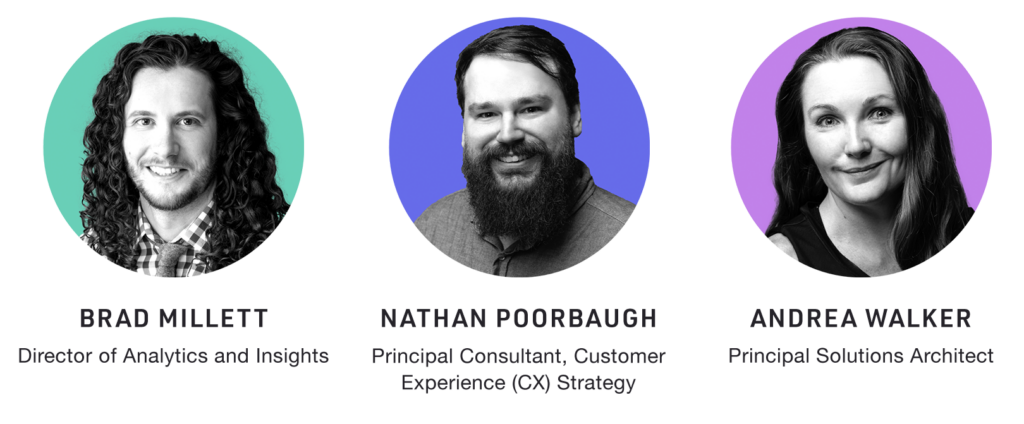“I’m a creative, not a technologist. What am I doing here?!” quipped screenwriter and director Aaron Sorkin when he looked over the sea of around 10,000 attendees at last week’s annual Adobe Summit in Las Vegas. The concept of creativity in the technology space was reemphasized by Adobe CEO Shantanu Narayen during the opening keynote address: “Even with all the technological advancements made regarding the customer experience, putting creativity to work to further accelerate innovation and drive customer growth is just as or even more important than ever.” With this year’s theme focusing on experience-led growth, enabling creators to ideate, strategize, and execute these experiences at scale was prevalent and paramount.

To better recap the collective insights of BlastX Consulting subject matter experts, I sat down with my colleagues who also attended Adobe Summit: Brad Millett, Director of Analytics and Insights and Nathan Poorbaugh, Principal Consultant, Customer Experience (CX) Strategy.
Enjoying the Chemistry of In-Person Events
Andrea Walker: What did you enjoy most about Adobe Summit this year?
Brad Millett: It’s hard to say. There were a few things that really struck me as an analyst and consultant. Just being in person with the analytics community again was a thrill. I feel like it’s a tight-knit community, even though there were 20,000 people in attendance. There definitely seems to be a larger focus on the experience and the holistic customer experience. I feel like that’s been something that’s been a long time coming, and it’s been a slow burn. I remember a few years ago when they first changed the Marketing Cloud to the Experience Cloud. It’s taking a little while for everybody to follow suit, but that seems to be a big focus and was great to see in my opinion.
Nathan Poorbaugh: Honestly, it was just good being back. I remember going to Adobe Summit before the pandemic and a part of me wondered if we would ever get back to that vibrant, collaborative experience. It was great hearing about, and seeing, all the cool innovations coming out. I think we’re going to see many of those innovations take flight in coming years as the barrier to entering the market lowers every day. It’s incredible how quickly the market is moving. As a consultant in Customer Experience (CX) strategy, the opportunities and challenges for brands are both at an all-time high.
Andrea Walker: What were some other types of innovation, both technologically and strategically, that really resounded for you coming out of Adobe Summit?
Nathan Poorbaugh: Centralizing the customer before making presumptive decisions with data. While there are systems that put things together to deliver both a target customer and data viewpoint, it’s more an outcome based on a more advanced or mature process. Now, however, it’s common to have that centralized customer view well established rather than constructing it after the fact with data. We’re even seeing that with Adobe and the move to AEP (Adobe Experience Platform) being the centerpiece of their overall stack. The data isn’t the center point anymore. The customer is, and honestly, that’s cool from both a technological and strategic perspective.
Then there’s AI. In 2023, we’re going to see it everywhere and we saw some very fascinating implementations of it at Summit, even in some smaller solutions. One solution which stood out to me was Coveo, which seemed to have a fascinating marketing play. The Firefly App, Adobe’s foray into AI, was another big solution announced at one of the keynotes.
Future Advancements Worth the Excitement
Andrea Walker: What were some features or solutions from Adobe Summit that our industry should pay more attention to this coming year?
Brad Millett: When I think about the solutions that were featured, it starts with the Product Analytics announcement. You could always do product analytics with Adobe Analytics, but to me, it’s a shift in focus that I think we should be paying attention to. For years, I think the perceived core of Adobe Analytics was as a digital marketing analytics tool. But, like Nathan said, everything is now centered around the customer and their experience. With the focus being on product analytics, it really brings that focus towards optimizing the experience on the platform. It’s less about advertising and more about treating your website like it’s your product and the type of metrics you use to better gauge performance.
Andrea Walker: So, Nathan, does that ring a bell? Remember when we had Adam Greco on the BlastX LinkedIn series “On the Mark” talking about this convergence of digital analytics?
Nathan Poorbaugh: I do, and it jibes with what I saw at Adobe Summit 2023. Having a view of the product as well as a view of the customer makes centralized data the best option. I also want to add that no-code solutions, like Co-Pilot, are going to be huge. Going forward, this is one of the ways that the technical barrier will continue to break down. We now have assistance which can help us design the programs we want to build without needing to know technical coding languages.
Brad Millett: One of the coolest innovations I saw was in the “too hot for main stage” session. In this session, we saw some things product managers are working on in the super early innovation process. One feature they showed was Business Intelligence Integration. This feature would allow analysts to write simple SQL queries where they select the dimensions and metrics they care about, instead of needing to recreate dimensions using complex SQL queries and ensure their numbers match what they see in Adobe Analytics. This feature would then convert that simple SQL query into API calls so you can drag and drop your dimensions in any BI solution like Tableau or Power BI.
Main Themes to Carry Forward
Andrea Walker: Last question to you both. What did you think the main themes were at Adobe Summit? For me, it was where creativity starts and stops alongside technology. There’s a lot that AI can do, but it’s still a technical tool and there are humanistic elements we can’t ignore. What are your thoughts?
Nathan Poorbaugh: We’re looking at brand new paradigms, but like you said, Andrea, what we’re seeing is people using technology as a co-collaborator for innovation and creativity. That’s going to be one of the primary themes for the next few years.
Brad Millett: Fundamentally, I don’t think AI will take over our jobs anytime soon. Instead, it’s going to create a system that favors those who do our jobs well with the assistance of AI and that helps us do our jobs better.
Nathan Poorbaugh: Technology won’t replace people for a very long time in my opinion, specifically because of the edge cases. You can code something for 90% or 95% of a job, but that 5% to 10% is what could lead to big costs or gains—so having humans involved in the process is going to be vital.
Final Thoughts
Overall, Adobe Summit 2023 highlighted the shift towards customer-focused methodology with technology bolstering innovation. I also touched on the importance of a “life-centric” customer approach during my talk on “Three Ways to Put the Customer Back in Customer Journey Mapping.” Marketers focused on customer journeys may like the new enhancements to the Customer Journey Optimizer that are natively built into Adobe Experience Platform and will integrate with Firefly.
If you would like to receive a complimentary copy of my presentation on Customer Journey Mapping, feel free to download the PDF presentation here. If you’d like to go one step further and chat with us about helping your team with your Customer Experience strategy and activation, reach out to BlastX Consulting today.

